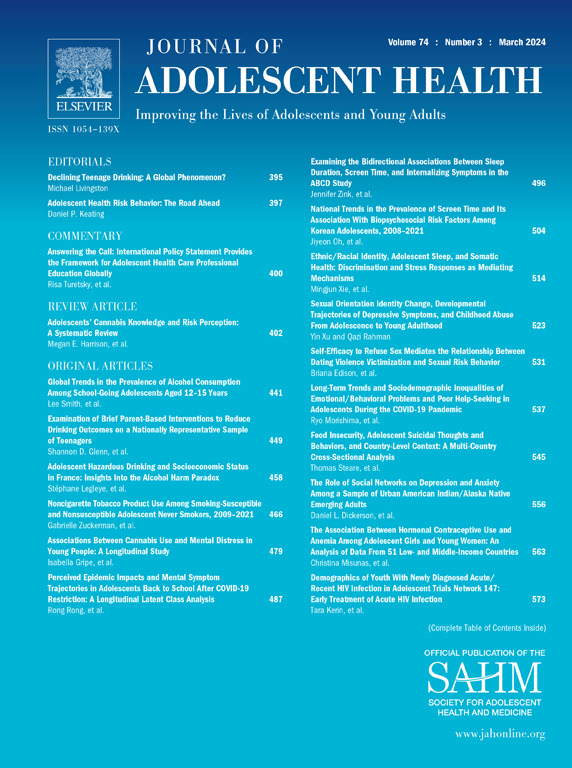印度尼西亚青少年的心理健康问题:利用经过验证的量表和创新的抽样方法进行横断面研究的结果。
IF 5.5
2区 医学
Q1 PEDIATRICS
引用次数: 0
摘要
目的:本研究旨在估算印度尼西亚青少年心理健康问题的发生率,并确定潜在的风险和保护性暴露:采用创新的抽样方法,同时在雅加达(城市大城市)和南苏拉威西(偏远省份)招募 16-18 岁的在校和社区青少年。我们对在校青少年(1,337 人)采用多阶段聚类抽样,对校外青少年(824 人)采用受访者驱动抽样。心理健康采用两个经过验证的量表进行测量:Kessler-10 和流行病学研究中心抑郁量表-修订版。为了验证自我报告量表,对雅加达的一个子样本(N = 196)学生进行了心理访谈:据估计,校内青少年的心理困扰和抑郁发生率分别为24.3%(95% CI = 21.5-27.2)和12.6%(10.5-14.4),校外青少年的心理困扰和抑郁发生率分别为23.7%(20.7-26.7)和23.5%(20.4-26.5)。在完成心理访谈的参与者中,常见的心理疾病有社交焦虑、抑郁和自杀。与在校女生相比,在校男生的心理困扰(16.9%(13.1-20.7)对 30.4%(26.4-34.4))和抑郁(10.1%(7.2-13.1)对 14.6(11.4-17.8))发生率较低。相比之下,在失学青少年中,男性的心理困扰(25.2% (21.6-28.9) vs. 20.2% (15.1-25.3))和抑郁(26.3% (22.5-30.1) vs. 16.9% (11.8-21.9))发生率更高。尽管认为有需要,但没有寻求医疗保健的在校青少年更有可能报告心理困扰和抑郁:青少年心理健康问题在印尼非常普遍,而且因性别、地域和入学率的不同而存在很大差异。这项研究及其取样和测量方法可作为改进其他环境下心理健康监测的范例。本文章由计算机程序翻译,如有差异,请以英文原文为准。
Mental Health Problems Among Indonesian Adolescents: Findings of a Cross-Sectional Study Utilizing Validated Scales and Innovative Sampling Methods
Purpose
This study aimed to estimate the prevalence of mental health problems and identify potential risk and protective exposures for adolescents in Indonesia.
Methods
An innovative sampling approach was applied to simultaneously recruit school- and community-based adolescents aged 16–18 years old from Jakarta (urban megacity) and South Sulawesi (remote province). We used multistage cluster sampling for in-school (N = 1,337) and respondent driven sampling for out-of-school (N = 824) adolescents. Mental health was measured using two validated scales: Kessler-10 and Center for Epidemiologic Studies Depression Scale-Revised. Psychiatric interviews were conducted in a subsample (N = 196) of students from Jakarta to validate the self-report scales.
Results
The estimated population prevalence of psychological distress and depression were 24.3% (95% CI = 21.5–27.2) and 12.6% (10.5–14.4) for in-school and 23.7% (20.7–26.7) and 23.5% (20.4–26.5) for out-of-school adolescents, respectively. In participants who completed a psychiatric interview, common psychiatric morbidities were social anxiety, depression, and suicidality. Compared to in-school females, male in-school adolescents reported a lower prevalence of psychological distress (16.9% (13.1–20.7) vs. 30.4% (26.4–34.4)) and depression (10.1% (7.2–13.1) vs. 14.6 (11.4–17.8)). By contrast, for out-of-school adolescents, males reported a higher prevalence of psychological distress (25.2% (21.6–28.9) vs. 20.2% (15.1–25.3)) and depression (26.3% (22.5–30.1) vs. 16.9% (11.8–21.9)). In-school adolescents who did not seek healthcare despite a perceived need were more likely to report psychological distress and depression.
Discussion
Adolescent mental health problems are highly prevalent in Indonesia, with substantial variation by gender, geography, and school enrolment. This study and its approach to sampling and measurement may serve as a model to improving mental health surveillance across other settings.
求助全文
通过发布文献求助,成功后即可免费获取论文全文。
去求助
来源期刊

Journal of Adolescent Health
医学-公共卫生、环境卫生与职业卫生
CiteScore
10.40
自引率
3.90%
发文量
526
审稿时长
46 days
期刊介绍:
The Journal of Adolescent Health is a scientific publication dedicated to enhancing the health and well-being of adolescents and young adults. Our Journal covers a broad range of research topics, spanning from the basic biological and behavioral sciences to public health and policy. We welcome a variety of contributions, including original research papers, concise reports, literature reviews, clinical case reports, opinion pieces, and letters to the editor. We encourage professionals from diverse disciplines such as Anthropology, Education, Ethics, Global Health, Health Services Research, Law, Medicine, Mental and Behavioral Health, Nursing, Nutrition, Psychology, Public Health and Policy, Social Work, Sociology, and Youth Development to share their expertise and contribute to our mission of promoting adolescent health. Moreover, we value the voices of young individuals, family and community members, and healthcare professionals, and encourage them to submit poetry, personal narratives, images, and other creative works that provide unique insights into the experiences of adolescents and young adults. By combining scientific peer-reviewed research with creative expressions, our Journal aims to create a comprehensive understanding of the challenges and opportunities in adolescent and young adult health.
 求助内容:
求助内容: 应助结果提醒方式:
应助结果提醒方式:


